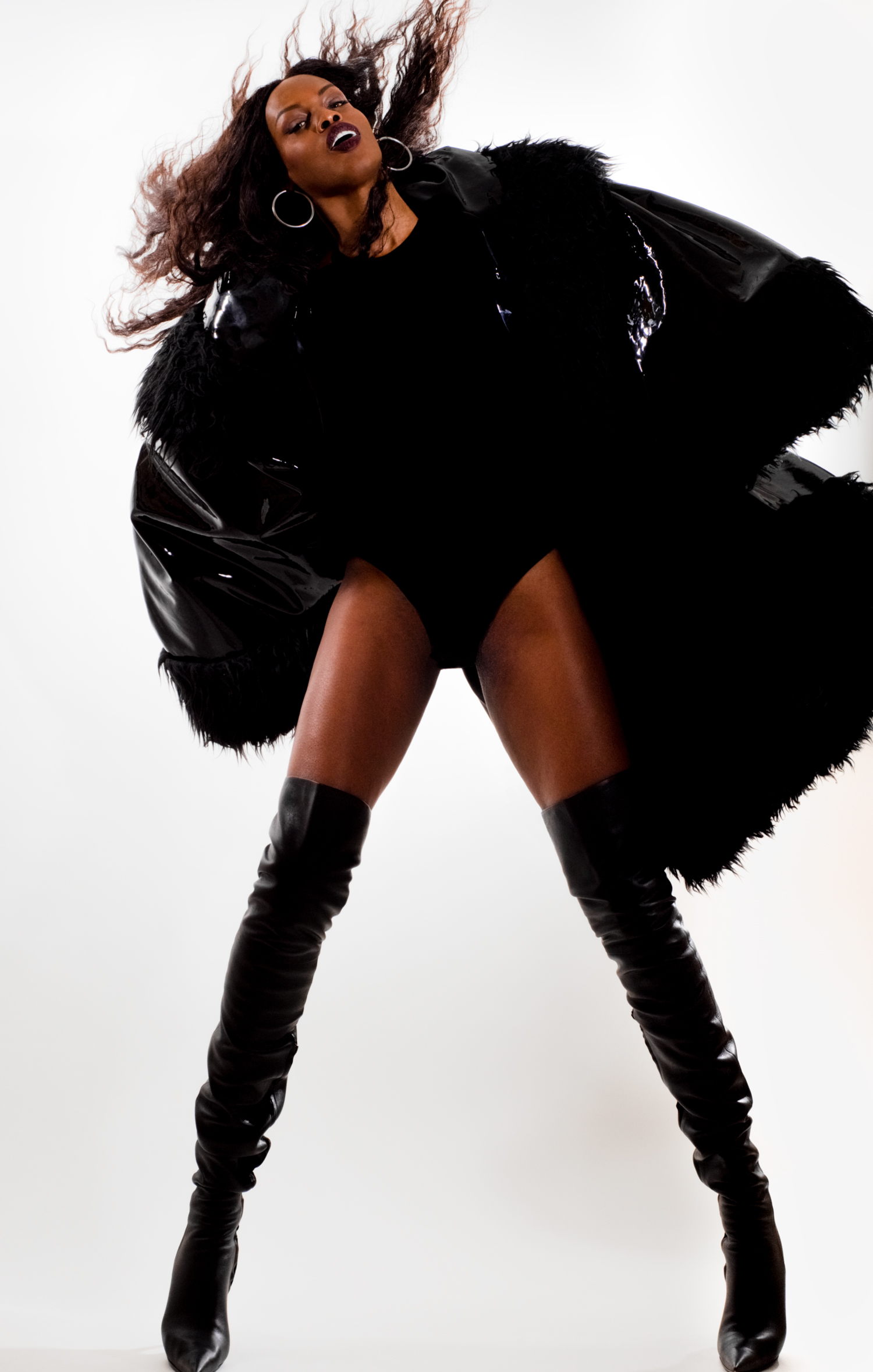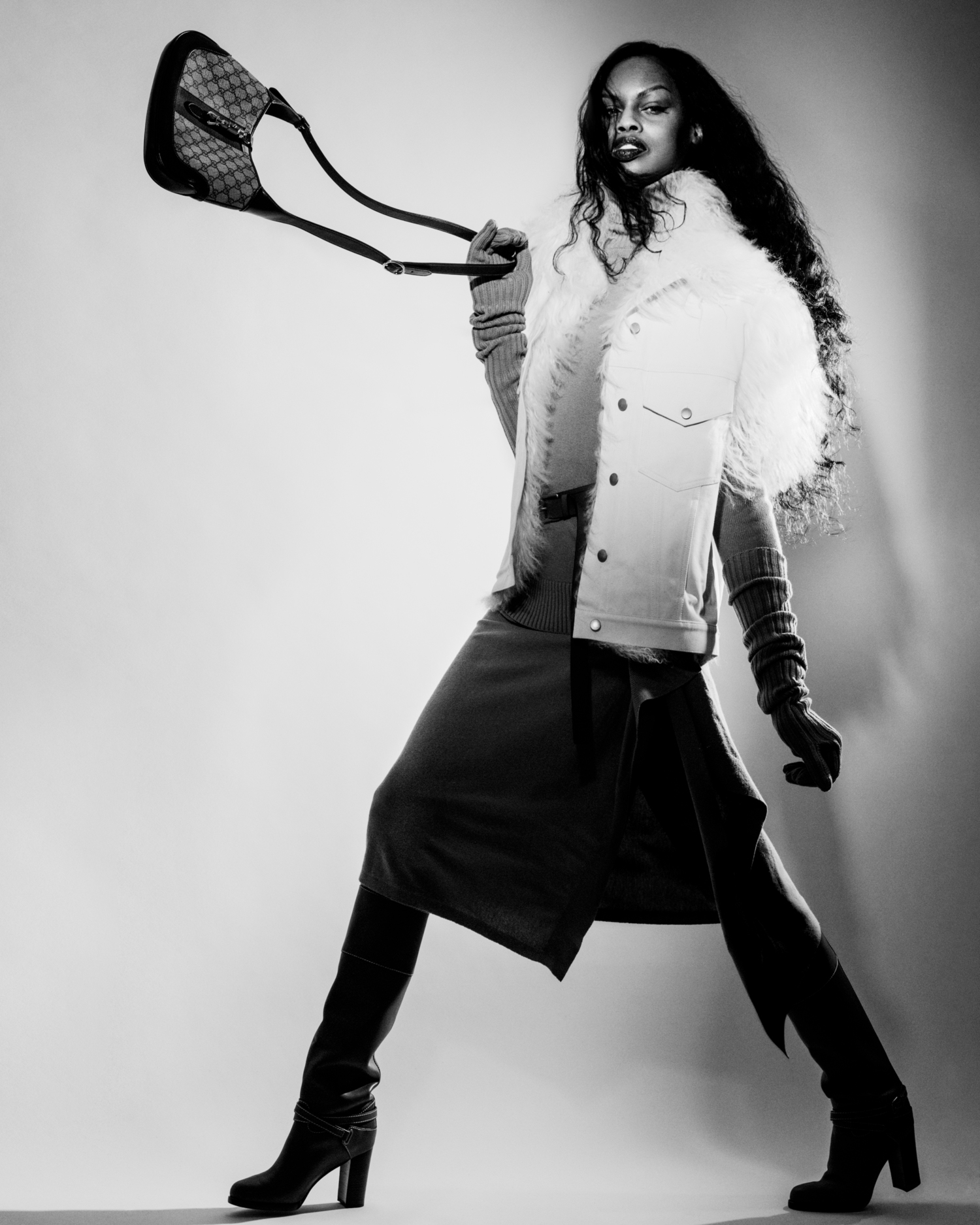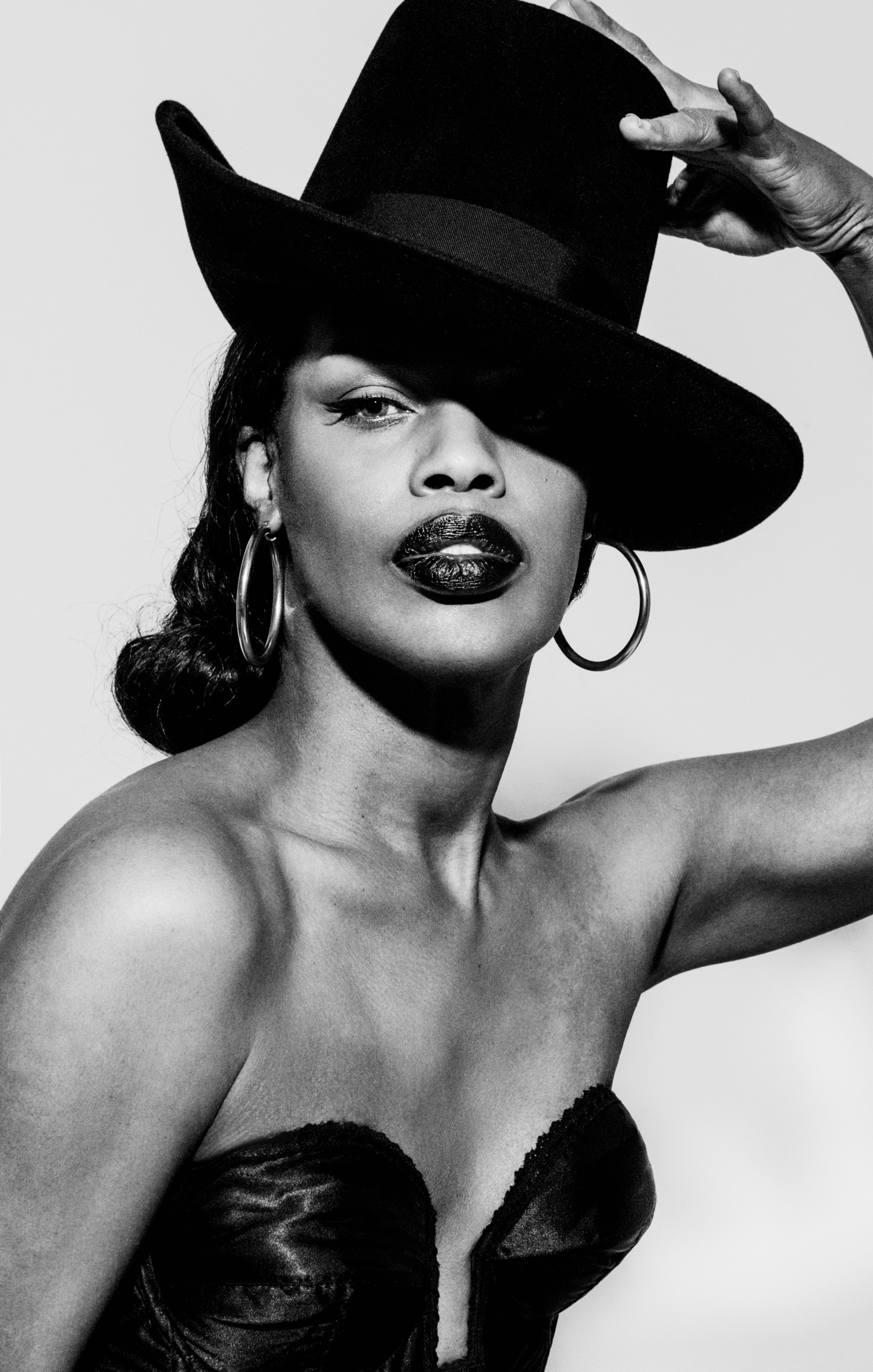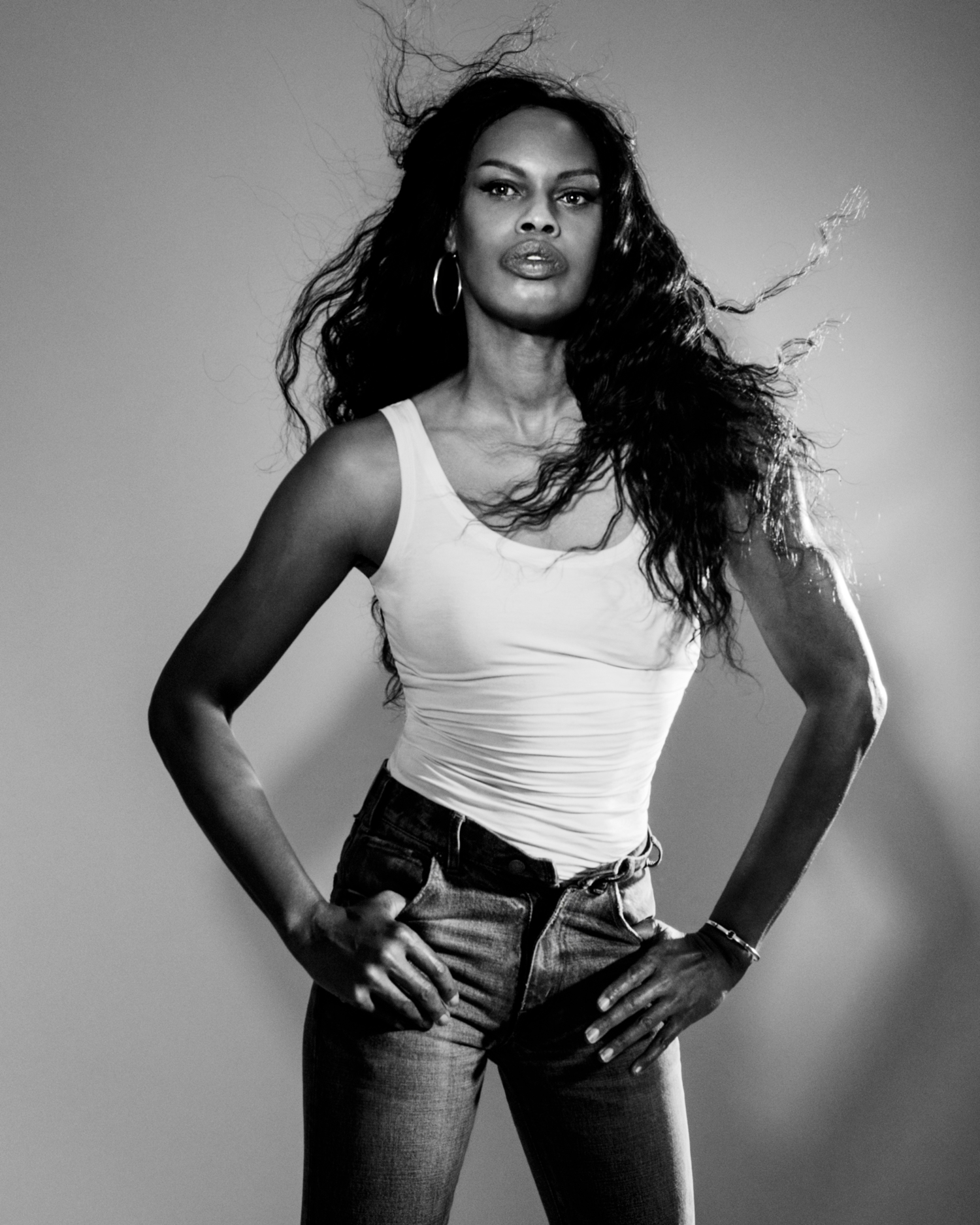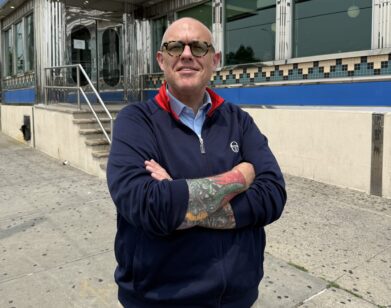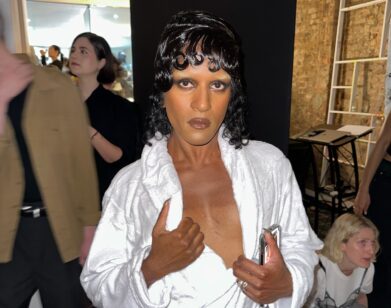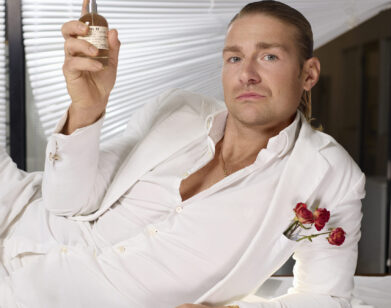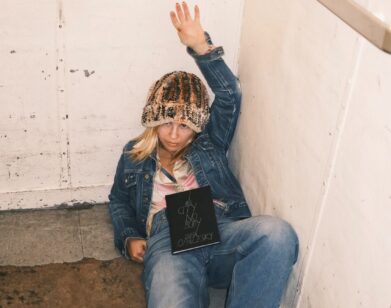Is your name on the list?
Connie Girl and Honey Dijon on Being at the Wrong Place at the Right Time
“Don’t fuck with Connie.” In the early ’90s, club kids across New York City knew that the toughest doorperson in town was Connie Fleming. A guardian of the city’s nightlife temples, the Jamaica-born, Brooklyn-raised Fleming, known as Connie Girl to those around her, became famous for not taking shit from anyone. It was an armor-like attitude she cultivated as a Black trans woman trying to navigate her own gender expression in a world that was often reluctant to keep up. Shy at first, Fleming joined the Boy Bar Beauties, a renowned drag troupe that gave her strength and provided a safe community in which to transition. It also revealed her to be a natural performer. People began to notice, and soon Fleming was posing for Steven Meisel and being hired to model for Thierry Mugler and Vivienne Westwood. George Michael couldn’t resist her, either, casting Fleming in his “Too Funky” music video alongside Tyra Banks and Linda Evangelista. And while her groundbreaking presence can sometimes get overlooked, when Honey Dijon decided to move from Chicago to New York to become a superstar DJ, it was Fleming who helped her believe that anything was possible.
———
HONEY DIJON: How are you, girl?
CONNIE FLEMING: Trying not to let Miss Corona make me go crazy.
DIJON: I’ve already gone crazy. My life changed overnight. No Ibiza, and I’ll be lucky if I DJ outside of Germany until 2021. I’m up in this bitch.
FLEMING: Is Germany still quarantining?
DIJON: No. Germany had a really great response to the whole virus. Everyone pretty much followed orders.
FLEMING: Do you mean you have a female leader [Angela Merkel] who knows about science and has a fuck- ing brain and said, “Get in your house and shut the fuck up”?
DIJON: Motherfuckers listened! It’s been quite wonderful to be here during this pandemic because we’re still able to go out, and even though we’re practicing social distancing, we’re able to have some semblance of life. I don’t know how I would have survived in New York.
FLEMING: We can go out. I have my dog Suki, and me and my mom walk her three times a day.
DIJON: I like to think I know so much about you, but I don’t know a lot of the backstory. My first introduction to you was visually. I’d seen you in pictures and seen videos of you performing before I moved to New York. You were always this mythical creature for me, because I had never seen a mirror of myself. A colored gal. The only other one who really did it for me was Grace Jones because she was the first one who combined art, fashion, music, theater, and performance.
FLEMING: And did not care.
DIJON: There were no fucks given at a time when you had to give a fuck. She really opened me up to the possibility, as a Black woman, of what I could do. When I was searching for myself, she was there. When I started my journey in life, there was nothing that I could look to that made me feel comfortable or gave me a vision of how I wanted to live my life. I saw images of you and I was like, “Who the fuck is this person?” It was right at the time when I was leaving Chicago and moving to New York. But we didn’t really connect until we went on tour together for Anohni—that’s when I think we had our first real bonding moment. Until then, you were this person I would see in Mugler shows and George Michael videos. But I couldn’t even fucking tell you where you were born or where you came from or what you did before. So can you enlighten a bitch?
FLEMING: I was born in Jamaica and we moved here when I was 5. I grew up in Brooklyn. It was difficult being a trans child, especially a Black trans child in a predominantly Jamaican neighborhood. It was serious trial by fire. I was bruised and beaten, but never dead. Art was my saving grace, because I could always draw and it was a point of goodness, a skill that didn’t make me a total freak. My first year of high school, I got into a situation in the gym and I never went back because it was traumatic and gross. I got my GED and took summer courses and evening courses at FIT to punch up and get my portfolio together. I got a job at the Antique Boutique on Broadway.
DIJON: Wow.
FLEMING: There I met [the drag performer and fashion designer David] Glamamore. We hated each other at the beginning because, well, when one cat sees another cat…
DIJON: When one girl spooks another girl, it’s game on.
FLEMING: So I paid her no mind and she paid me no mind until one day, we both went for the same dress. We both saw the label at the same time. It was a Mr. Blackwell dress.
DIJON: It’s always a test in New York.
FLEMING: A fashion test, and you have to pass.
DIJON: It’s either a club test or a fashion test. I always say that at that time in New York, you had to have something to offer or you had to have something smart to say. You had to know something in order for kids to pay you any attention.
FLEMING: If you weren’t in a full look, 24 hours a day—or if anybody saw you out of that look—you were done. You were a poser and a fake. So, one night after work, I went to Boy Bar. That’s when I met Matthew [Kasten, creator of the Boy Bar Beauties]. He was speaking with the owner, a famous hairdresser. He had pitched the idea of doing shows there. It was like a meeting of the minds and it was affirming. It was like he knew me without even know- ing me. A year later, I was a star, in a way. A star below 14th Street.
DIJON: Honey, a lot of shit happened below 14th Street, let’s not get it twisted.
FLEMING: I was in the right ’hood, at the right place, at the right time, and in some ways, the wrong place at the right time.
DIJON: I love that. That should be the title of your book. The Wrong Place at the Right Time by Connie Fleming.
FLEMING: A memoir.
DIJON: A memoir, darling, for your nerves.
FLEMING: My journey started there, at Boy Bar. It healed me in a lot of ways and got me out of my shell because, ultimately, I’m very introverted. The world opened up for me on that stage. It built up a broken child.
DIJON: Had you transitioned at this point?
FLEMING: It wasn’t until a year later. At the beginning, it was an education. An education on my history as an LGBTQ, African American person.
DIJON: The same thing happened to me when I came to New York. Our stories are so similar in a lot of ways. I came from the South Side of Chica- go, and got bullied a lot, but what saved me was fashion and art magazines. That’s where I found solace, happiness, education.
FLEMING: Light.
DIJON: And beauty in the world, because the world was so ugly. My parents moved me out to the suburbs and that was like an alien coming from Mars. What saved me was house music culture. When I moved to New York, I didn’t have the language to define who I was until I started hanging out with [Gant] Johnson, who we both know. He was a big DJ in the East Village scene. He introduced me to everyone. I became a part of this whole community of people. I’ll never forget this one night when, I think it was [the drag queen] Aphrodite—we were at Salon Wednesdays—said to me, “You belong in a dress.” It just sort of clicked in my head, what that meant. It was like the community of girls showed me who I was. They saw me before I saw myself. They gave me a language, they told me which doctors to go to and who to get my hormone shot from.
FLEMING: Let the church say, “Amen.”
DIJON: When I think of all the access that trans kids have today, the light that they have, and the opportunities that they can have—we lived in the dark. We lived in nightclubs. We lived at night.
FLEMING: We lived in the Wild, Wild West.
DIJON: Even getting medical care. There were many years when we did everything on the black market. Even the word “transgender” has only been around since, like, the early ’90s. People forget that before then, you were either a transsexual or you weren’t.
FLEMING: Or a transvestite.
DIJON: Then when you’re trans and you go to these crossdressing places, you’re like, “Well, that’s not me either.” People don’t understand the difference between having a trans identity or being gender nonconforming or nonbinary or transvestite. It’s different shades of gray. The other thing was that you never saw a lot of opportunities other than sex work or working in clubs.
FLEMING: Those were the two options: Walk on a stage or walk the corner.
DIJON: When did you finally decide that you were ready?
FLEMING: The [trans performer] International Chrysis had given me the April Ashley biography [April Ashley’s Odyssey by Duncan Fallowell, about an English model outed as a transgender woman by a newspaper in 1961]. I read it and I saw myself. It was always there, but the only thing I remember seeing before that was on The Phil Donahue Show.
DIJON: The circus.
FLEMING: They were like, “Poor things. They’re so delusional.” That narrative breeds violence and separation. So when I started to be out in the world, the working girls and performers protected each other, because if we weren’t going to protect each other, no one was. Not even our own gay and lesbian brothers and sisters were going to protect us at that point.
DIJON: Well, unless you were entertaining them.
FLEMING: That was your only value. The party clown.
DIJON: How did you go from perform- ing to walking runways?
FLEMING: I’d been performing for a good three years before [the costume designer] Patricia Field and [the fashion designer] Andre Walker came to a show, at which point, I got up the gumption and said, “Let me go full tilt.” I had the safety net of my tribe and Boy Bar in order to transition. I couldn’t have transitioned while working at McDonald’s. That’s the thing that the kids don’t understand.
DIJON: I tell people all the time about passing. You have this new generation where they can blend genders and they can express however they want to. But back in the day, passing made the difference between whether or not you were going to make it home at night.
FLEMING: Life or death.
DIJON: This is why I take nightclubs so seriously, because if I hadn’t had those spaces, I wouldn’t have been able to make a living. Did you ever imagine that you would be a model?
FLEMING: It was a fantasy. I was a colored girl. But there were all of these people around me who were like, “We see you.” I think Steven Meisel or his assistant came and saw me. And the Azzedine Alaïa book was coming out, so everyone was like, “Get her now.” I went and shot with Steven, which was like a scene from [the 1983 film about the modeling industry] Portfolio. Have you ever seen Portfolio?
DIJON: Of course. And it blew me away, because I’m obsessed with Steven Meisel. Did you know about Teri Toye? It was you and Teri for me. There are trans models now, but at that time you didn’t even speak about it.
FLEMING: Or you did, but in hushed tones.
DIJON: How did you meet Thierry Mugler?
FLEMING: It was at the first Susanne Bartsch Love Ball. People had been telling him about me. I don’t remember what I said to him that first time. I had on the highest heels and the tiniest waist and the tightest ponytail. And he was like, “Oh, that’s what they are talking about.” He invited me to Paris that next year. That was my first show with him.
DIJON: Did you already have the walk?
FLEMING: Yes, that was already honed in.
DIJON: Where did you get that walk from?
FLEMING: It was a mixture of the goddess Pat Cleveland, with a little bit of Mounia and a dash of Khadija [Adams].
DIJON: I loved Khadija. Wasn’t she royalty? No one talks about her.
FLEMING: There is no Givenchy, YSL, or Valentino—none of it—without those girls.
DIJON: How many years did you work with Mugler before the whole George Michael thing happened?
FLEMING: About two to three years later, we went to L.A. to do the first APLA Health show for AIDS. George Michael was in the audience, and that’s where the idea for the “Too Funky” video gelled.
DIJON: You’re literally a part of pop culture history. Even though we have conversations about trans models today, I still don’t see Black girls. Any time you see a fashion house dealing with trans-ness, it’s still a white girl. I don’t see any Latin girls.
FLEMING: There are a couple of Latin girls and there are a couple of Black girls, but it’s very second to third to fourth thought.
DIJON: I’m all about being the thing you want to see. That’s why I’m out in the world trying to do as much work as I possibly can, because I realized that I needed to stop asking for permission and stop waiting for someone to choose me. Were you making the kind of money that all the other girls were making?
FLEMING: I didn’t make any real money from modeling. I still had to work. I held down a steady, real income between trips back and forth to Paris.
DIJON: You became a notorious door girl, this presence in New York: “Don’t fuck with Connie.” You became so legendary for letting the kids have it.
FLEMING: Don’t forget. I’m a Black trans woman. There’s no respect. You neither had to listen to me nor pay me any mind. So that’s what I was confronted with. In that job, I couldn’t so much as blink.
DIJON: When you think about us as trans women, the intersection of gender and identity politics that we have to deal with, you’re not respected or listened to. But then when you speak up and you have some authority, you either become the angry Black boy or that Black bitch at the door.
FLEMING: Right after RuPaul’s “Supermodel” came out, I remember TV shows calling me up and asking if I wanted to be on. I was like, “No, I’m not that. I can recommend someone for you, but I’m trans and I can’t be on your program.” Then the promo ran and what was it? Footage of me!
DIJON: I feel like we’re still considered entertainment, even in fashion. Our femininity is there for shock and entertainment.
FLEMING: Me being on Mugler’s runway, that should have been the end of his business. People thought no one would ever buy from him anymore. But his business did not go up in smoke. How does my presence and my being offend you?
DIJON: I think it’s just fear. What I’ve learned is that most people don’t know who the fuck they are. I don’t understand why our femininity is so threatening to cis people or even to gay people. We’re marginalized within the marginalization.
FLEMING: We are the ones who go out and do the grunt work.
DIJON: One of the greatest things I can say about what trans-ness means for me is that it’s about dismantling cisgender gender norms and dismantling what it means to be a sexual person. What it means to be a woman.
FLEMING: It’s not that that’s never been seen before, or even manifested by cisgender women like Grace Jones or Marlene Dietrich. They created their personae. A lot of it has to do with internalized misogyny and patriarchy.
DIJON: Most people don’t want to take responsibility for who they are. One of the most magical moments of my life was when we went touring with Anohni, who had the foresight to bring together all of these different girls from different backgrounds and with different gender expressions. To me, it’s still one of those milestones in my life. We were all creating beauty from all of our pathways. It was one of the most beautiful experiences I’ve had in my life.
FLEMING: That tour energized me and built me up. I saw light, beauty, and a future.`
This article appears in the September 2020 issue of Interview Magazine. Subscribe here.
———

